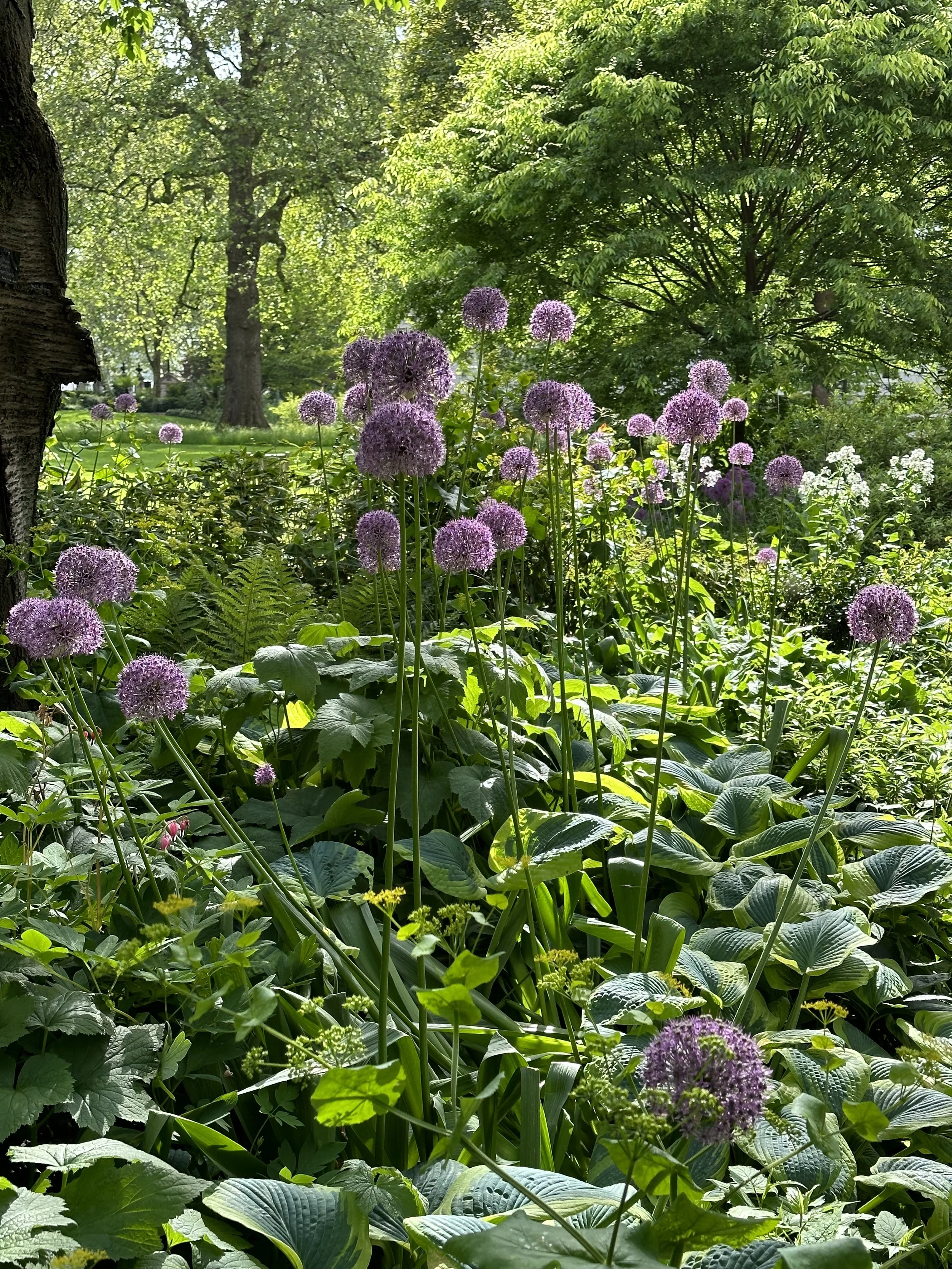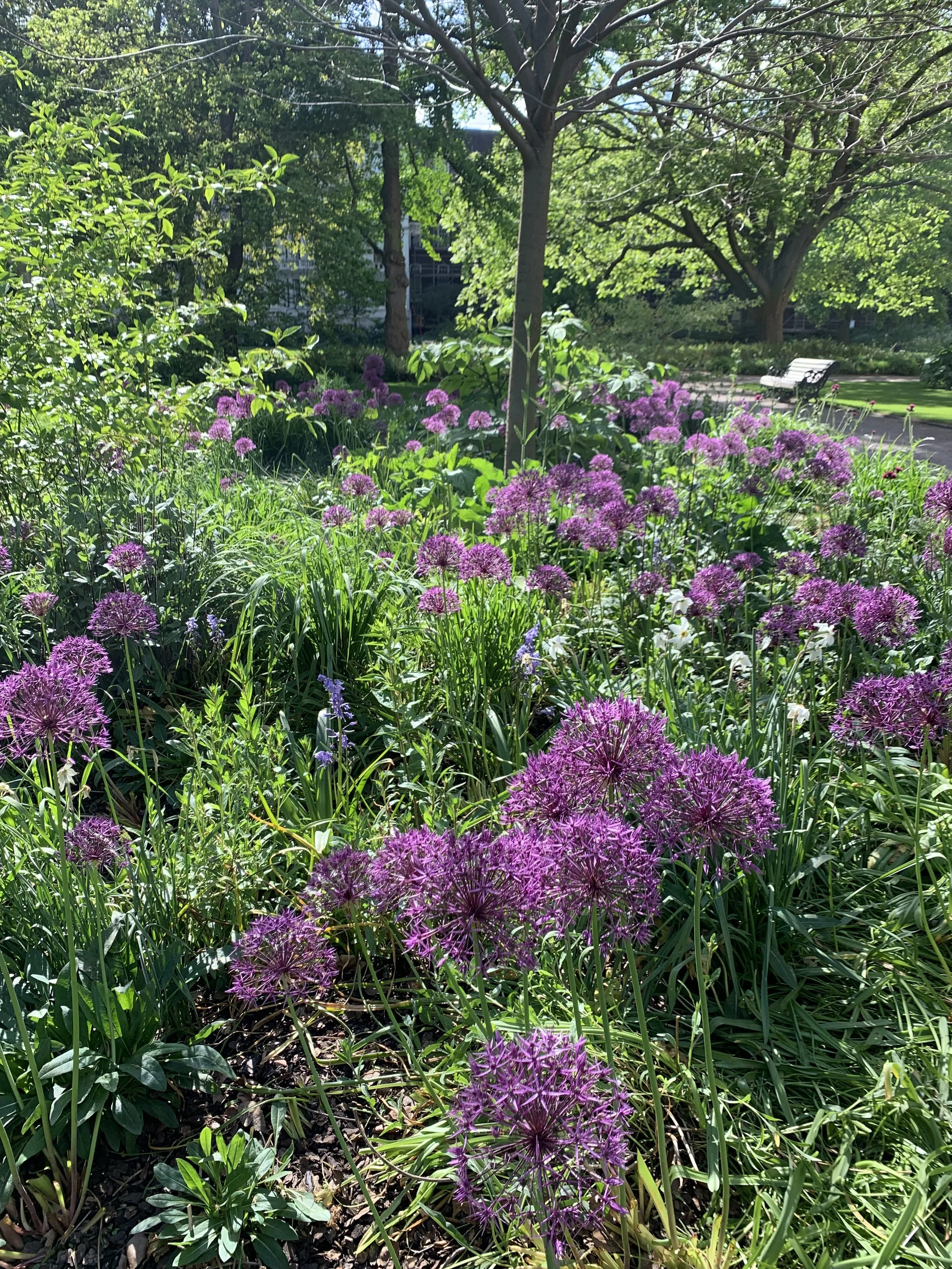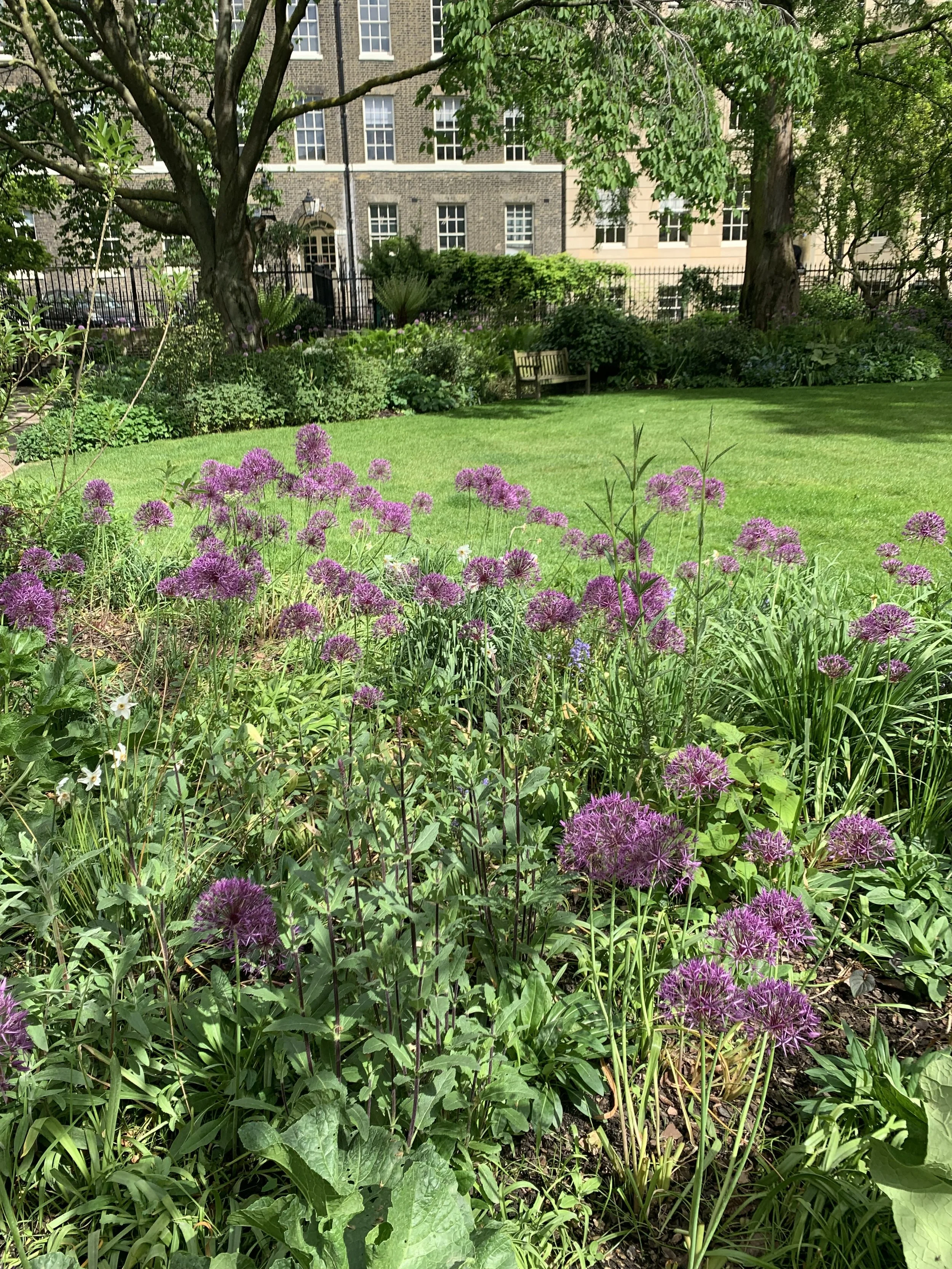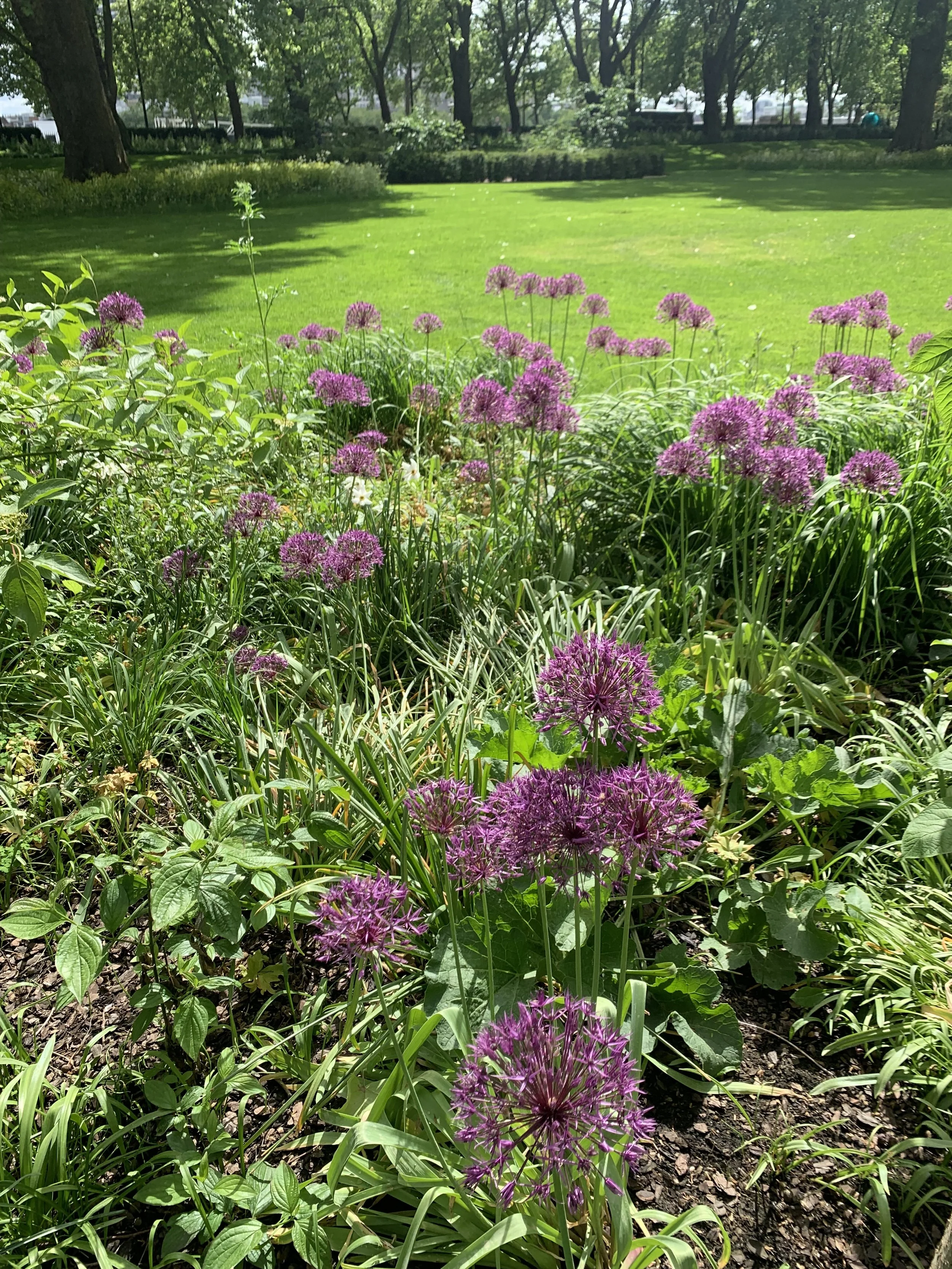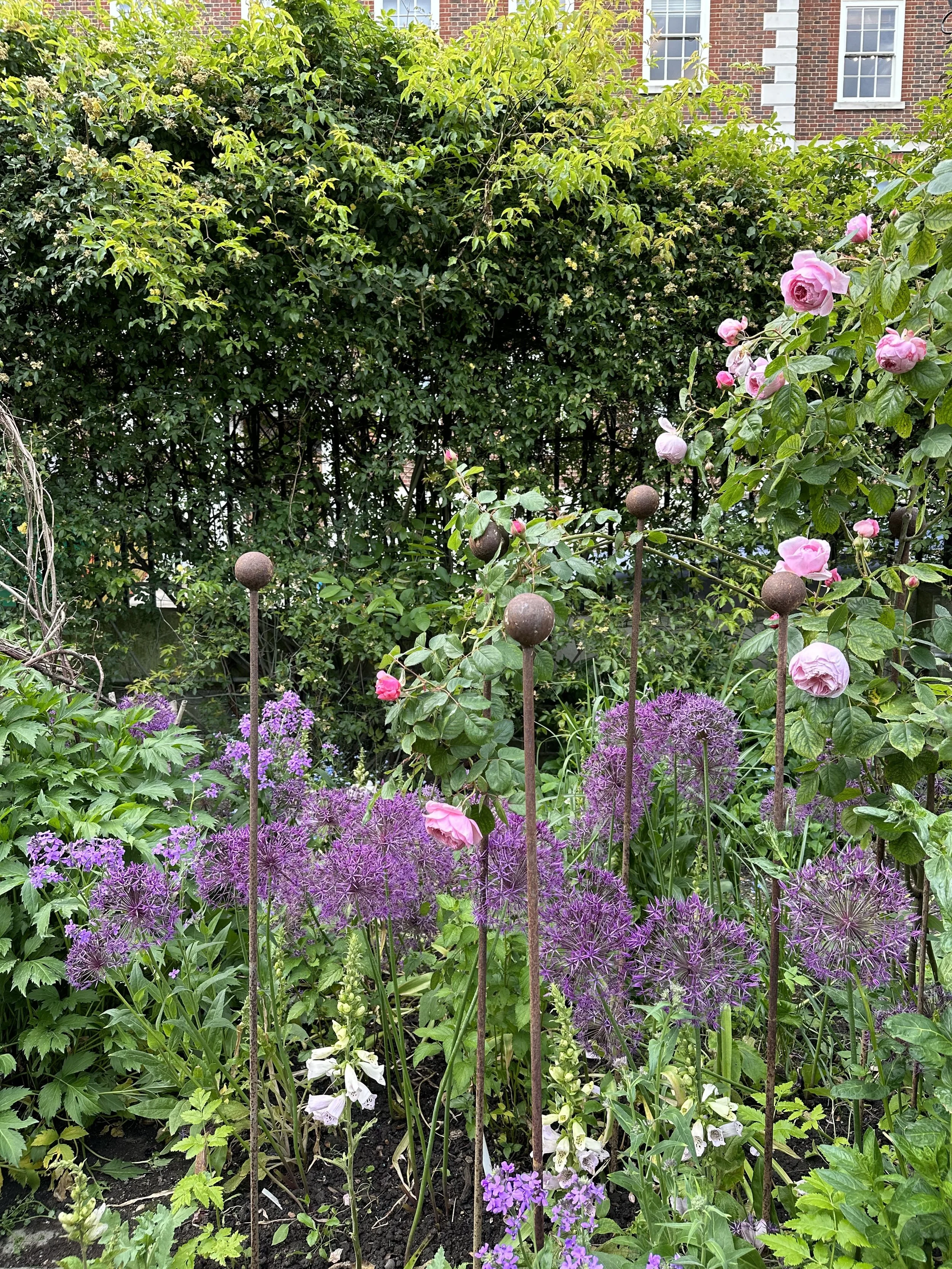Secrets to Successfully Planting Allium Bulbs
This article has links to products that I may make commission from.
Alliums, with their sculptural elegance and diverse variety, have become a cornerstone of modern garden design.
Whether you're looking to liven up a cottage garden or simply enhance a pot on your patio, understanding how to plant allium bulbs can create an impact that's hard to match.
In the world of gardening, few experiences rival the joy of seeing planted bulbs burst forth with vibrant purple flowers come springtime.
Not only are these blooms a visual treat, but many of them, especially certain allium varieties, are remarkably drought tolerant.
This resilience makes them a prime choice for gardeners across various zones, even in areas where water is a luxury.
But to truly let these flowers thrive, ensuring the right ratio of sand, compost, and loam is crucial for achieving well-drained soil.
Dive into my guide to understand the nuances of planting and nurturing these captivating bulbs.
To learn more about growing bulbs, check out my guides:
The beautiful allium plantings at Inner Temple Garden where I volunteered.
Allium Planting Guidelines
Successfully growing alliums hinges on understanding and adhering to the specific requirements these bulbs have.
Here's a comprehensive breakdown to ensure your alliums thrive:
Fall Planting:
Most allium varieties are best planted in the fall, a few weeks before the ground freezes.
This allows the bulbs to establish roots before winter, setting them up for a vibrant spring bloom.
Spring Planting:
Some allium types, like Allium oreophilum and Allium moly, can be planted in spring for a later bloom.
Ensure they're planted as soon as the soil is workable.
Light Requirements:
Alliums thrive best in full sun positions, receiving at least 6-8 hours of direct sunlight daily.
A west-facing or south-facing garden location is best.
While they prefer full sun, some alliums can tolerate light shade, especially during the hottest parts of the day.
Soil Considerations:
One of the most critical factors for alliums is well-draining soil.
Waterlogged conditions can lead to bulb rot.
While they're not overly picky, a fertile soil enriched with compost or well-decomposed manure can boost their growth.
A pH level of 6.0 to 7.5 is generally ideal.
Before planting, it's beneficial to loosen the soil to a depth of about 12 inches to facilitate root expansion.
Planting Depth & Spacing:
A rule of thumb for planting allium bulbs is to set them at a depth 2-3 times their diameter.
For instance, if a bulb is 2 inches tall, it should be planted 4-6 inches deep.
Proper spacing ensures adequate air circulation and room for growth.
Most varieties should be planted 3-6 inches apart, but giant varieties might need more space.
For a more fun bulb-planting techniques, check out my guides:
Planting Alliums in Pots
Drainage:
Pots should have drainage holes to prevent waterlogging.
Spacing in Pots:
When planting allium bulbs in pots, give them a bit more space, approximately 1-3 inches apart, depending on the bulb size.
Potting Mix:
Use a high-quality potting mix that allows for good drainage.
If planting in pots, here is the potting mix I recommend:
Planting Alliums in the Ground
Grouping:
For a more dramatic effect, consider planting bulbs in groups or clusters rather than individually.
This will result in a bolder splash of color when they bloom.
Companion Planting:
Alliums pair beautifully with perennial plants that can mask their foliage, which tends to wither before or as they bloom.
Consider companions like daylilies or hostas.
For more companion planting tips, check out my guide: How to Pair Marigold Companion Plants.
Labeling:
Given the myriad of allium varieties and their varied bloom times and heights, consider labeling where and which type you've planted.
This assists in future garden planning and bulb care.
Post Planting Care and Tips
Once you've planted your allium bulbs, the journey doesn't end there.
Proper post-planting care is crucial to ensure healthy growth and maximum flowering potential.
Here's how to care for your alliums in the months and years after planting:
Watering:
Initial Hydration:
After planting, give your alliums a good watering to help establish roots.
This promotes good contact between the soil and the bulb.
Regular Watering:
Alliums don't need frequent watering due to their drought tolerance.
However, during extended dry periods, especially when bulbs are forming roots or during flowering, water them once a week.
Overwatering or letting them sit in soggy soil can cause bulb rot.
Fertilizing:
Spring Feeding:
In the spring, as new growth appears, a balanced, slow-release fertilizer can support vigorous growth.
Avoid high-nitrogen fertilizers as they may encourage more foliage than flowers.
Fall Nourishment:
Applying bone meal in the fall can bolster the bulb's health for the following season.
Here is the bone meal I recommend:
Pruning & Deadheading:
Deadheading:
Once alliums have flowered, the flower heads can be deadheaded (removed) to send more energy back to the bulb, unless you prefer the aesthetic of dried flower heads.
Foliage Care:
Let the foliage die back naturally.
The leaves photosynthesize, producing energy that's stored in the bulb for the next year's growth.
Resist the urge to cut back the foliage until it has fully yellowed and withered.
Pest and Disease Management:
Natural Defense:
Alliums' natural oniony scent acts as a deterrent to many pests, but if you notice any adverse conditions, treat with an organic insecticidal soap or neem oil.
Diseases:
Good planting practices, like ensuring well-drained soil and proper spacing, will largely prevent most diseases.
Fungal issues can be addressed with eco-friendly fungicides.
Bulb Storage & Division:
Storing:
If you need to store allium bulbs before planting, keep them in a cool, dry place.
They should be stored in mesh bags or paper bags with holes to ensure good air circulation.
Division:
Over time, allium bulbs may become crowded.
Every 3-4 years, consider digging up, dividing, and replanting them in the fall to rejuvenate and spread their beauty.
Tips for Longevity:
Mulching:
A light layer of mulch can help conserve moisture and keep soil temperatures stable.
Check out my guide: The Best Alternatives to Traditional Mulch for Your Garden.
Here is the mulch I recommend:
Companion Planting:
Plant alliums among other perennials that will cover the dying allium foliage but still allow their tall flower heads to show.
Good partners include hostas, ferns, and ornamental grasses.
Monitor Growth:
Keep an eye on how your alliums are growing.
If they seem stunted or aren't flowering, it may be time to divide or supplement with bulb-boosting fertilizers.
Ready to plant more bulbs?
Check out my guide to The Top 3 Bulbs that Flower in Winter.
Popular Allium Varieties
While there are over 700 species of alliums, certain varieties stand out for their beauty, hardiness, and unique characteristics.
Let's dive into the varieties that I recommend:
Purple Sensation:
Description: Known for its vibrant, rounded clusters of deep violet flowers.
Height & Width: Typically reaches heights of 2-3 feet with flower heads about 3-4 inches across.
Planting Tips: Great for borders due to its tall, slender stalk and striking color. Blooms in late spring.
Here are the ‘Purple Sensation’ bulbs I recommend planting:
Mount Everest:
Description: As the name suggests, this variety stands tall with pristine white flowers.
Height & Width: Grows up to 3-4 feet tall with flower heads around 5 inches across.
Planting Tips: Pairs beautifully with darker plants, creating a contrast. Blooms in late spring to early summer.
Here are the ‘Mount Everest’ bulbs I recommend:
Allium schubertii:
Description: Often likened to a firework display, this allium boasts an explosion of lavender flowers that shoot in various directions.
Height & Width: Stands about 1-2 feet tall with dramatic flower heads stretching up to 12 inches across.
Planting Tips: Makes a statement as a centerpiece in garden designs. Blooms in late spring.
Here are the Allium schubertii bulbs I recommend:
Allium moly:
Description: A sun-loving allium, it showcases bright yellow, star-shaped flowers.
Height & Width: Grows up to 10-15 inches tall. The flower clusters are less spherical than other alliums but are dense and vibrant.
Planting Tips: Ideal for rock gardens or edging. Blooms in late spring.
Here is the Allium moly I recommend:
Allium giganteum (Giant Allium):
Description: True to its name, this variety boasts gigantic, spherical purple blooms.
Height & Width: It's one of the tallest, growing up to 4-5 feet with flower heads spanning 5-6 inches.
Planting Tips: Acts as an excellent focal point given its size. Blooms in late spring to early summer.
Here is the Allium giganteum I recommend:
Allium sphaerocephalon:
Description: Also known as the drumstick allium, it has elongated, oval-shaped, deep purple to burgundy blooms.
Height & Width: Reaches a height of 1-3 feet with small, tightly packed flower heads.
Planting Tips: Perfect for adding a touch of elegance to borders. Blooms in early to mid-summer.
Allium oreophilum (Pink Lily Leek):
Description: Offers delicate, star-shaped, pink flowers.
Height & Width: Reaches about 10 inches in height, making it one of the shorter allium varieties.
Planting Tips: Suitable for rock gardens, edges, and containers. Blooms in late spring.
Choosing the right allium variety largely depends on the gardener's vision and garden design.
From tall, bold giants to dainty, delicate blooms, there's an allium for every garden style and dream.
Experiment with a mix or find your favorite, and let these blooms transform your garden's landscape.
For more bulb planting tips, check out my guide:
Alliums 101
Alliums are a diverse and captivating group within the onion family, but their aesthetic value surpasses their culinary roots.
They serve not only as a bridge between spring and summer blooms but also as architectural wonders that can redefine landscapes and gardens.
Origin and Family:
Alliums belong to the Alliaceae family, which includes onions, garlic, and chives.
Though many members of this family are cultivated for culinary uses, ornamental alliums are appreciated primarily for their blooms.
Color Spectrum:
When most gardeners think of alliums, images of striking purple spheres often come to mind. While this is not off the mark, alliums showcase a broader spectrum.
The pristine white flowers of 'Mount Everest' contrast beautifully against varieties like 'Purple Sensation'.
There are even yellow-flowering types such as Allium moly, which can provide a sunny splash to gardens.
Height & Width:
Alliums are incredibly varied in size.
The diminutive Allium oreophilum might peak at just 5 inches, while the grand Allium giganteum can tower over other garden plants at 4 feet or more.
The width of their flower heads can be equally impressive, with some like the Allium schubertii stretching to an astonishing 12 inches across, resembling a floral firework display.
Texture and Shape:
Beyond just height and color, alliums are a favorite among garden designers for their unique textures and shapes.
Their spherical blooms can add an element of geometric precision amidst softer, more traditional flowers.
This can play a pivotal role in garden design, creating eye-catching focal points and contrasts.
Position in Garden Design:
Given their distinctive heights and sphere-like blooms, alliums can be used in a multitude of ways in garden designs.
They can stand tall as individual focal points, be clustered for dramatic impact, or be interspersed among lower-growing plants to create a layered effect.
For more inspiration, check out my guide:
Benefits of Growing Alliums
Alliums, beyond their eye-catching aesthetics, bring numerous advantages to gardens and gardeners alike.
Here's why many choose to incorporate them into their landscapes:
Drought Tolerance:
Economical Watering:
Once established, alliums require minimal watering, making them ideal for regions with water restrictions or for gardeners looking to conserve resources.
Resilience in Harsh Conditions:
Their ability to withstand dry periods means they remain vibrant even when other plants might wither, ensuring a consistent garden display.
Cut Flowers:
Extended Vase Life:
Alliums, especially varieties like 'Purple Sensation' and 'Allium sphaerocephalon', are not just beautiful in gardens but can also be enjoyed indoors.
Their longevity as cut flowers means they remain fresh-looking for an extended period.
Unique Bouquet Addition:
Their distinct spherical shape can transform ordinary bouquets into something extraordinary, offering both texture and height.
Pest Resistance:
Natural Repellent:
Given their onion family lineage, many pests avoid alliums.
This can reduce the need for chemical interventions, promoting a more organic gardening approach.
Beneficial Insect Attraction:
While many pests avoid them, alliums can attract beneficial insects like bees, which can enhance pollination in your garden.
Media and Garden Shows:
Garden Design Inspiration:
Due to their standout appearance, alliums often grace the pages of garden design magazines and are featured prominently in garden shows.
Growing them can offer a touch of professional design to personal spaces.
Versatility in Garden Design:
Layering and Texturing:
Their varied heights and widths allow for strategic placement, creating depth and layers in garden designs.
Seasonal Bridge:
As they bloom between spring and summer, alliums ensure there's no visual gap in flowering, ensuring a continuous splash of color in gardens.
Incorporating alliums into garden spaces can provide not just visual delight but also practical benefits, reinforcing their position as a must-have in contemporary gardening.
Whether it's for their resilience, beauty, or utility, alliums have solidified their place in the hearts of gardeners worldwide.
For more ideas, check out my guide:
Allium Planting FAQs
What month is best to plant allium bulbs?
Most allium bulbs are best planted in the fall, typically from September to November, a few weeks before the ground freezes.
This allows them to establish roots before winter and ensures a vibrant bloom come spring.
Some specific varieties, like Allium moly and Allium oreophilum, can also be planted in early spring for a later bloom.
How many allium bulbs should I plant together?
It's often recommended to plant allium bulbs in groups of at least three to ensure a more striking display, especially for the larger varieties.
For a more dramatic effect, you can plant them in larger clusters or drifts.
The exact number also depends on the space available and the desired density of the flowering area.
Do allium bulbs multiply?
Yes, allium bulbs can multiply.
Over time, a single allium bulb can produce offsets, leading to a cluster of bulbs.
This natural propagation means that, over a few seasons, a solitary bulb can result in a more substantial grouping of plants, leading to denser flowering.
It's also one reason why gardeners might consider dividing mature bulbs every few years to prevent overcrowding and to spread the beauty elsewhere in the garden.
How do you plant allium bulbs the right way up?
Allium bulbs typically have a pointed end and a flatter base.
The pointed end is the top, and this is the side that should face upwards when planting.
The flatter base, where roots grow from, should face downward.
If you're ever unsure, it's worth noting that even if bulbs are planted upside down, they'll usually still manage to grow correctly, as they'll naturally send shoots upwards and roots downwards.
How deep to plant allium bulbs?
The general guideline for planting allium bulbs (or most bulbs, for that matter) is to plant them at a depth of 2-3 times their own height.
For example: For large allium varieties like Allium giganteum, which have bulbs that may be 2-3 inches tall, they should be planted 6-8 inches deep.
For smaller allium varieties, which have bulbs roughly an inch or less in height, they should be planted 2-3 inches deep.
However, there are a couple of things to keep in mind:
Soil Type: In lighter, sandy soils, you can opt for the deeper end of the range. In heavier, clay soils, plant slightly shallower.
Mulching: If you are planning to add a thick layer of mulch on top, factor that into your planting depth. The mulch effectively raises the ground level, so you can plant the bulbs a bit shallower.
Always check specific planting recommendations for the particular allium variety you have, as there can be slight variations. And ensure that the soil is well-draining to avoid bulb rot.
Remember, whether in the ground or in pots, the key to successful allium growth is ensuring proper drainage to prevent bulb rot.
